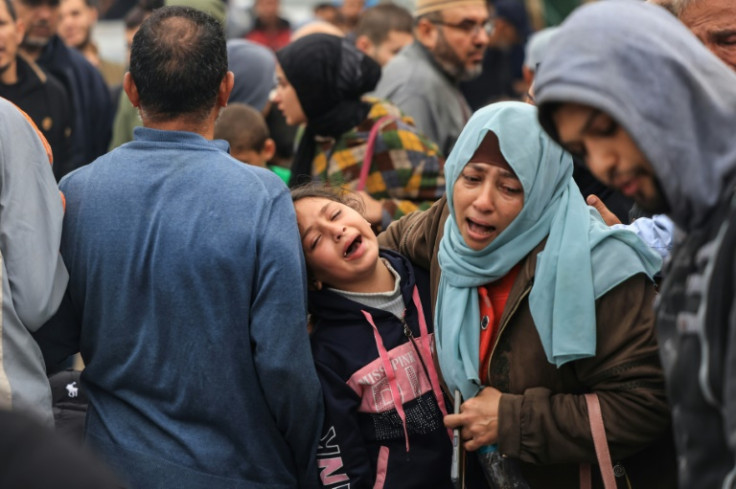Israeli forces battled Hamas militants in Gaza’s main southern city on Wednesday in some of the most intense combat of the two-month-old war sparked by the October 7 attacks.
The focus of the conflict has shifted into the besieged territory’s south following fierce fighting and bombardment that reduced much of the north to rubble and forced 1.9 million people to flee.
Israeli troops, tanks, armoured personnel carriers and bulldozers have rolled into Khan Yunis in the south, Gaza’s second biggest city, forcing already displaced civilians to pack up and flee again, witnesses told AFP.
“Our forces are now encircling the Khan Yunis area in the southern Gaza Strip,” Israel’s army chief Herzi Halevi said Tuesday.
“We have secured many Hamas strongholds in the northern Gaza Strip, and now we are operating against its strongholds in the south.”
The fighting was “the most intense day since the beginning of the ground operation” in late October, said the army’s Southern Command chief Major General Yaron Finkelman.
The streets of Khan Yunis were almost empty on Wednesday morning as residents tried to take shelter from shelling and artillery fire, said AFP journalists, while the dead and wounded continued to pour into the city’s hospitals.
Israel declared war on Hamas after the militant group’s October 7 attacks that killed 1,200 people, mostly civilians, according to Israeli authorities, and saw around 240 hostages taken.
The latest toll from the Hamas-run government media office said 16,248 people in Gaza, most of them women and children, had been killed.
Israel has vowed to destroy Hamas and free 138 hostages still held after scores were released during a short-lived truce.
In a morning briefing the army said it had struck about 250 targets in the Gaza Strip over the past day and that troops were “continuing to locate weapons, underground shafts, explosives and additional military infrastructure”.
The civilian mass casualties in Gaza have sparked global concern, heightened by dire shortages brought by an Israeli siege that has seen only limited supplies of food, water, fuel and medicines enter.
Hassan Al-Qadi, a displaced Khan Yunis resident, said “the whole city is suffering from destruction and relentless shelling.
“Many people arriving from northern Gaza are facing dire circumstances. Many are homeless and some are searching for their missing children.”
“We are not mere numbers. We are human beings,” he said, speaking in the southern city of Rafah.
The violence in Gaza “now ranks amongst the worst assaults on any civilian population in our time and age”, charged aid group the Norwegian Refugee Council, which also warned of the dire public health threat of the approaching winter.
Several Hamas commanders were killed in an air strike near the Indonesian Hospital in northern Gaza, the Israeli military said early Wednesday on social media platform X.
Sources in Hamas and Islamic Jihad, another Palestinian militant group, told AFP their fighters were battling Israeli troops early Wednesday in a bid to prevent them from breaking into Khan Yunis and surrounding areas.
According to the Hamas-run government media office, dozens were killed and injured in heavy strikes on areas east of Khan Yunis.
The Hamas-run health ministry said air strikes on the Nuseirat refugee camp in central Gaza killed six people and wounded 14 others.
Israel had previously told civilians in the north of the densely populated Gaza Strip to seek shelter in the south of the territory, with many fleeing to Khan Yunis believing it would be safer.
As the war expands, Israel has told people to move even further south, sparking “panic, fear and anxiety”, according to Philippe Lazzarini, head of the UN agency for Palestinian refugees, UNRWA.
People were being pushed into an area that is less than one-third of the Gaza Strip, with roads to the south clogged, he said.
International aid groups have condemned the succession of orders to flee from one area to another, saying that civilians were running out of options.
“Nowhere is safe in Gaza,” said United Nations humanitarian chief Martin Griffiths. “Not hospital, not shelters, not refugee camps. No one is safe.”
Following demands to create areas where civilians could shelter, Israel’s army published a map it said was intended to enable Gazans to “evacuate from specific places for their safety if required”.
But the UN criticised the map, saying it was impossible to create safe zones for civilians to flee to inside Gaza.
“The so-called safe zones… are not scientific, they are not rational, they are not possible, and I think the authorities are aware of this,” said James Elder, spokesman for the UN children’s agency UNICEF.
An estimated 1.9 million people are displaced in Gaza — roughly 80 percent of the population, according to UN figures.
Gazans, their belongings piled onto donkey carts, battered vehicles and camels, have headed further south to try to escape the expanding Israeli offensive.
In northern Gaza, the Israeli military said it had encircled the Jabalia refugee camp and also raided a Hamas Internal Security Forces command and control centre.
It said Wednesday that the number of Israeli soldiers killed inside Gaza since the war began had risen to 83.
Fighting resumed after the collapse on Friday of a Qatar-mediated truce that saw scores of Israeli and other hostages released in exchange for Palestinian prisoners.
The war has sparked fears of a wider regional conflict, with frequent exchanges of fire with Iran-backed Hezbollah across Israel’s border with Lebanon.
A Lebanese soldier was killed by Israeli fire on a military post near the country’s southern border Tuesday, the army said.
The occupied West Bank has also seen an upsurge in violence.
Israeli troops raided Faraa refugee camp in the north of the territory early Wednesday, sparking clashes that killed two people, one of them aged 16, according to Palestinian news agency Wafa.
More than 250 people have been killed in the West Bank since October, according to Palestinian authorities.
AFP

AFP

AFP

AFP

AFP

AFP

AFP






